|
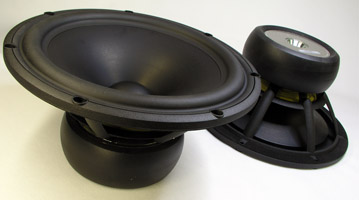
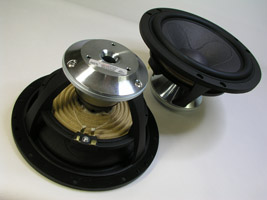
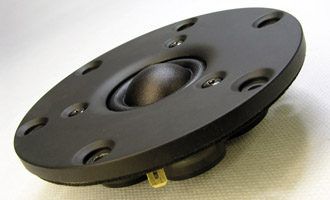
Click images to view large.
Download
specs here:
26W/8861T00
18WU/8741T00
D3004/660000
The primary
objectives of the Jenzen series of speakers are optimisation of
front panel layout for smooth midrange frequency response and the use
of stepped baffles in order to better acoustically align drivers for
implementation of true LR2 crossovers. Due to the stepped front panel
of
this design a
simplified crossover can be realised with enhanced transparency and
timbre quality. As can be seen from the crossover schematics below,
this has been accomplished.
The use of transmission line cabinets further adds to
the overall improvement in performance compared to Jensen 1071. TLs
also means more volume and for those with limited space - or WAF
trouble - a bass-reflex
design can be used.
Jenzen
Illuminator is a follow-up to Jensen 1071. I'll keep
the Jensen 1071 on the website as
quite a few people have built it - and liked it. Please check
builders' response here.
The drivers used here are pretty much state of the art from ScanSpeak
and I was keen to learn how good they perform compared to my Jenzen
Diamond speakers. These ScanSpeak drivers alone will set you back some
1700 EUR and then
comes cabinet materials and crossover kit. Not exactly cheap. The Jenzen Ill. takes a decent amp for
optimal performance and 100 watt is mandatory, preferably more if you
play it loud - because it can be played loud. I have an
un-compressed CD recording that could take the Jungson to clipping
when played really loud, but this was an exception. By-amping is a
viable option having a good work-horse driving the bass
section.
System sensitivity
is around 88 dB and minimum impedance is 3.5 ohms. Recommended
amplifier is 100 watt minimum, the more the better.
Recent experiences with ceramic and diamond domes has sharpened my taste for hard domes delivering enhanced
resolution without the sonic character of e.g. alu domes, thus the D3004/664000
beryllium dome tweeter was tried but didn't allow my target voicing of
this set-up. 6600, XT25TGs and 7100 tweeters were tried before I
finally decided on the 6600 dome.
The 18WU driver was recently used in the Illuminator
Monitor and there was no doubt in my mind this driver should
be tried in a Jenzen 3-way speaker as a midrange driver. These sandwich cones are good and
deliver enhanced resolution and reduced compression at high levels
compared to many other drivers. They don't come cheap but few drivers
come with the finish of these meticulously designed and crafted
drivers.
The bass driver used in the Jensen construction, 26W/8861T00, will
stay put. The 4 ohms 4867 alu bass would match the 8861 in
sensitivity but I tried the classic alu 8567 in the Jenzen TL bass cab and
it's good, but lacks the punch of the 8861. So, paper cone it must be
and the W26 holds the most rigid paper cone I've ever seen, providing
pistonic movement within its intended operating range. Another thing
is that a 4 ohm bass drivers would take overall system impedance
really low. With an 8 ohm bass driver we stay above 4 ohm in the
critical range.
The sound: Let's
start with the bass as the W26 loading the transmission line delivers
a clean and dry bass presentation, the best I've heard so far from
this driver. It's deep and well controlled and thanks to the LCR
circuit never becomes boomy. The bass blends very well with the
middriver and it's really hard to comment on the mid's presentation as
it just does what it's supposed to do, delivering a clean and
transparent midrange. It's a different meal compared to the Accutons,
but I'm certain the 18WU will have its audience from people wanting a
slightly more spicy midrange compared to the more neutral presentation
of the Accutons. The 6600 gels exceptionally well with the 18WU,
everything I'd hoped for - and an example of how far soft-domes have
come when it comes to power handling and transparency.
Generally transparency is exceptional for paper cone
drivers/soft-domes and a good match for my newly acquired Duro
power amplifier.
I won't go through numerous recordings with comments like I did with
the Jenzen
Accus as this would likely be repetitive, but being a long time
since I last heard Jan Garbarek's Rites and Keith Jarrett's Köln
Concert I put on these recording before finally deciding on a few
crossover issues - and the Jenzen Illuminator
speakers didn't let me down. I think the mid-tweeter integration is
among the best three I've ever made - and it does take a bit of luck
too. Initially I hadn't thought of the 6600 tweeter at all, but here
it excels in every aspect, which proves that synergy is a vital part
of driver mating. Front panel layout and crossover topology doesn't
always make things gel into a coherent soundstage no matter how good
it looks from simulation and measurements.
Siri's Killer Note?
No problem.
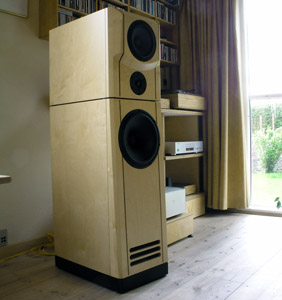
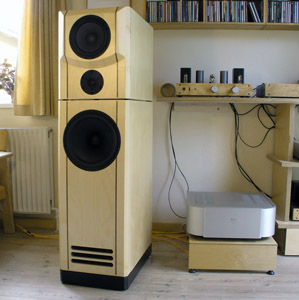
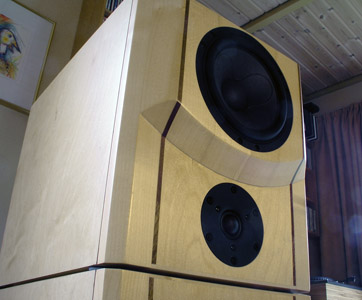
Click images to view large
These images were taken under
less than ideal illumination conditions. Here's a few more in
better light:
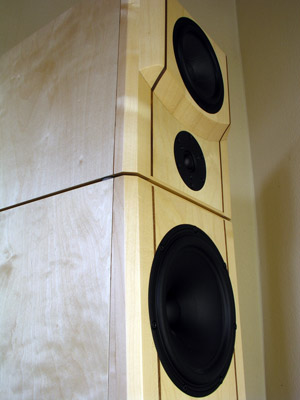
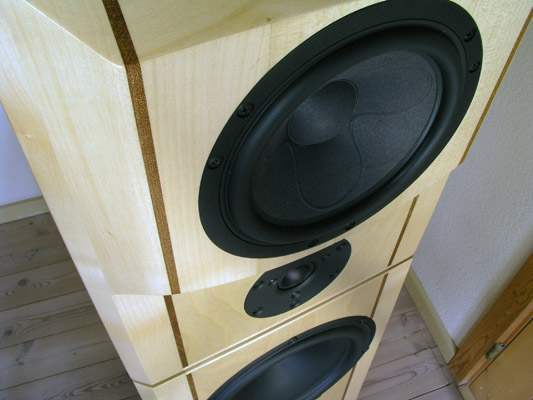
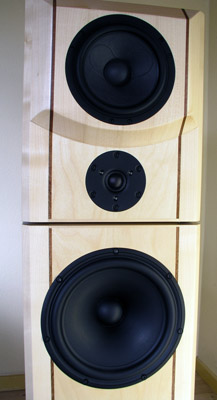
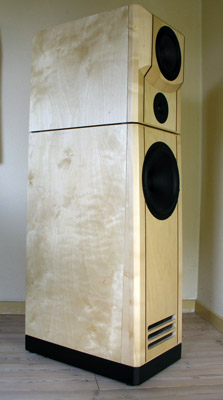
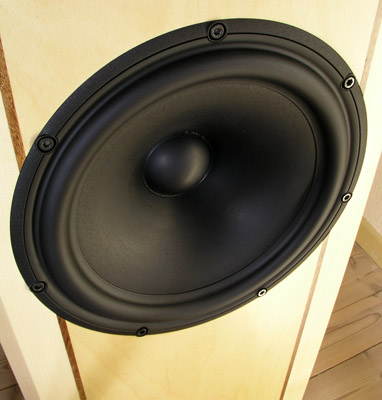
Click images to view large
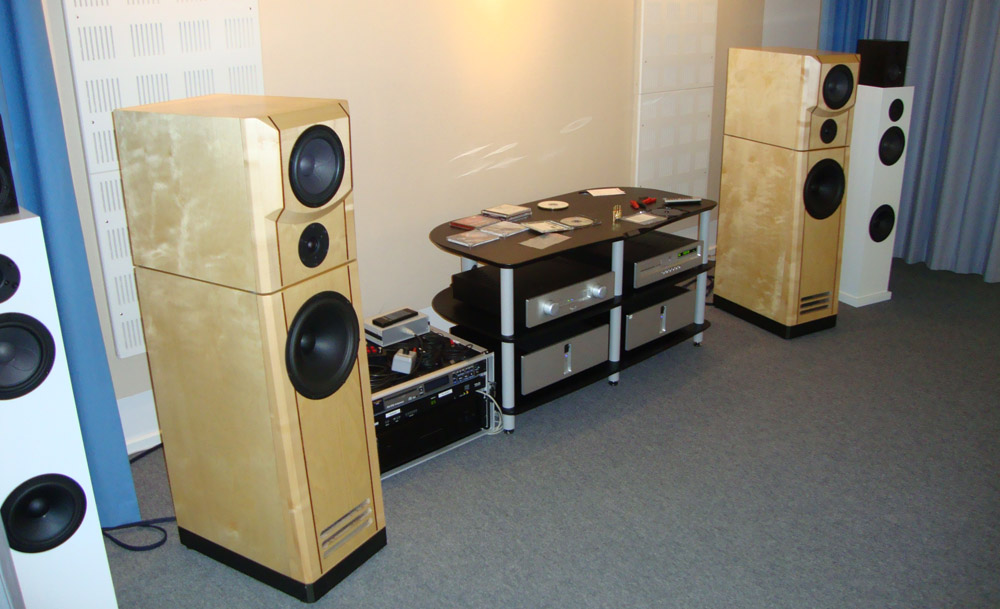
Jenzen Illuminator in the showroom at ScanSpeak factory.
FAQs
FAQs having the answer NO:
Do you have a solution for use of an electronic crossover between bass
and mid?
Can I make a flat front panel for mid and tweeter?
Can I make the MT
cabinet pyramid shaped with the tweeter on top?
Can you describe
the difference in bass performance between TL and BR?
Can I use the 6640 tweeter with the 6600 crossover?
Will you describe the difference in sound from this speaker and the
Accuton?
Useful links (Please
follow all links before e-mailing!):
http://www.troelsgravesen.dk/tips.htm
http://www.troelsgravesen.dk/tips.htm#CONSTRUCTION_OF_CROSSOVERS
http://www.troelsgravesen.dk/crossovers.htm
http://www.troelsgravesen.dk/LCR-RC.htm
http://www.troelsgravesen.dk/Inverted-Polarity.htm
http://www.troelsgravesen.dk/choices.htm
http://www.troelsgravesen.dk/power-handling.htm
Jenzen
Illuminator crossover
Back to top

Jenzen Illuminator crossover.
The Jenzen
Illuminator crossover follows as close as possible a LR2 topology.
Points of crossover are close to 200 Hz and 2,000 Hz. The bass LCR circuit
handles the peak building up at 100 Hz from the rising impedance due
to bass cabinet tuning. Due to the optimised mid-cab design a simple as
possible crossover for the 18WU driver can be achieved. The mid-driver
low-pass section is basically a 1st order filter providing a 2nd order
roll-off. Tweeter section features a single notch filters to linearise
impedance (500 Hz).
Mid-tweeter front panels have a 29 mm tweeter off-set making the
optimum listening window at tweeter height, which is my ear height
when sitting in my sofa. As can be seen from vertical dispersion
below, this is not critical. The mid panel thickness can be varied
from 27-29 mm without problems.
R1011 determines tweeter attenuation and can be varied from 2R7 to 3R9.
2R7 provides a nearly flat response, too bright and aggressive to my
taste. My default is 3R3, maybe a bit
brighter than I use to do, but the 6600 can handle it, but I'll
probably end up with 3R9. Don't forget to
try out the various resistors provided with the kit.
And again, the orientation of RC or RCL circuits doesn't matter. I
have this question regularly because my layout may differ from
schematics depending on size of components and the need to get coils
apart.
Choice of crossover
components:
Bass: The C-coils are ideal for bass drivers having a low point
of crossover to the mid. They can take immense amounts of power and
they're fairly compact too. The capacitors in the bass section could
all be electrolytic for that matter, but I have chosen a 82 uF
standard PP here. The notch-filter smoothing the 100 Hz region is
optional, but to my ears worthwhile. 220 uF in metallised PP would be
humongous, thus an electrolytic it must be.
Mid-driver: All caps here are important, not least the 88 uF
series caps, but cost for 88 uF is no more than a single dome tweeter
- and
it's worth every cent. For L2041 a wax/foil coil is chosen, where the
8.2 mH coil, L2021, can be a high-ohmic cored coil having a DCR = 0.8
ohm. In front of L2021 a 1 ohm resistor is placed making a combined
DCR of 1.8 ohm for this circuit. For C2041 a 0.33 uF Superior-Z is
used.
Tweeter: The 6600 dome's huge impedance peak at 500 Hz needs
linearisation and with the chosen low-slope
crossover, we need to smooth this peak and it takes a 100 uF capacitor.
You could use a 100 uF standard PP capacitor - although it does take
up quite some space - but extensive listening tests have not revealed
any negative impact on sound from being an electrolytic cap*.
*
2020: Replaced by 100 uF Premium Elko, smooth foil caps.
C1021 is
the most important component in the tweeter crossover, thus Silver-Z
used here, or even better Alumen-Z.
I recently worked on a
4" compression driver fitted with a 500 Hz horn and it needed a
notch-filter smoothing the 2-4 kHz range and was surprised to hear the
impact on sound quality from the parallel notch filter when fitted
with various types of capacitors. Super caps were clearly superior to standard
polyprops and it is clear that when a notch-filter is operational in an
area where the driver is working at full level - and in an area where
the ear is most sensitive - we have an issue with the quality of
components used. Makes good sense too I should say. For a
notch-filter working 2 octaves below point of crossover (impedance
smoothing), capacitor quality seems of less - if of any - importance,
thus electrolytics will do.
So, to the common question on what components are the most critical we
can conclude that it all depends on where in the frequency band it is
operating, what it is doing and not least, how much it
is doing. Fortunately we don't need any notch-filters here
where drivers are working full level.
Jenzen
Illuminator Cabinet
Back to top
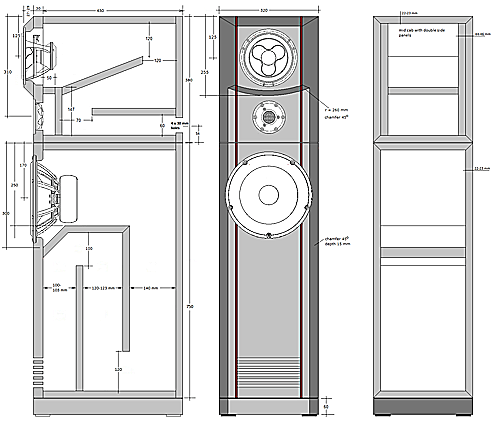
Click image above to download
large.
Go to Jenzen cab
construction page here.
At bottom of page you will find instruction on damping materials and
in particular damping of the TL, which is important for making the
bass performance optimal.
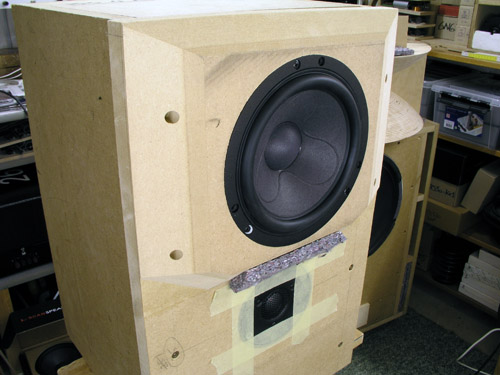
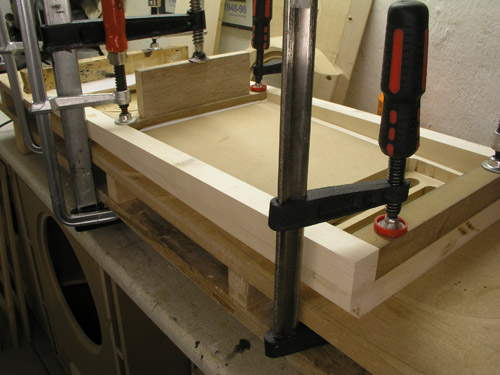
Left: Optimising front panel layout.
Right: Adding fillets to front
panel for tilt. I'd never do it this way again, but cut cabinet side
panel to desired tilt.
The small tilt has no impact on performance,
I just thought it looked good.
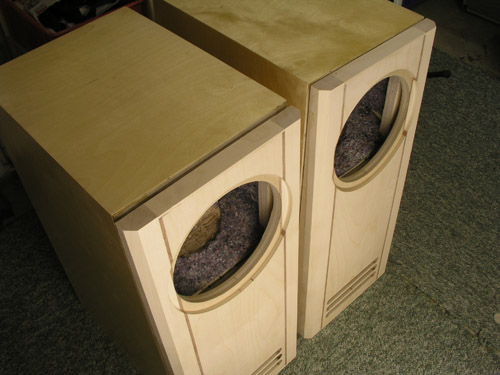
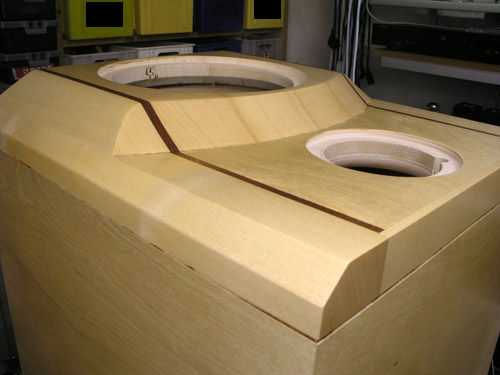
These Jenzen cabs will have their final
front panels after housing the Jenzen ER, NEXT, Accu and D.
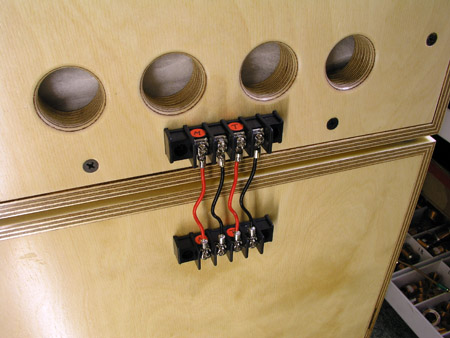
The four mid cab 30 mm ventilation holes
finishing the TL
Vented option:
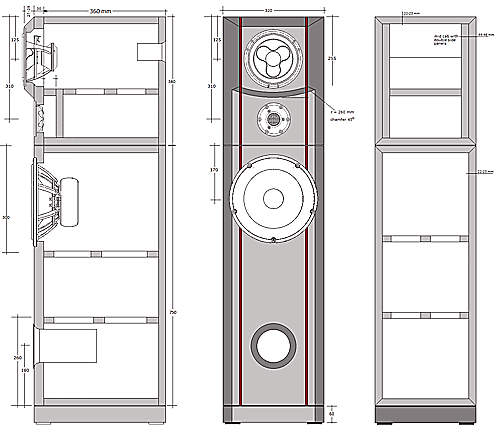
If you cut depth to 360 mm (depth without front panel) you get 65 litres and
F3 = 33 Hz. Port tuning is 25 Hz and port is 80 x 220
mm. I suggest making a rectangular port from MDF and 32 x 200 mm, length
= 280 mm. This is equivalent to a port diameter of 90 mm.
With this new cabinet depth for the mid/tweeter - and by removing internal panels - we
have around 25 litres minus volume of tweeter cab and bracings. This fits the
18WU well and I suggest adding a port to the rear of 50 mm (ID) x 75
mm. Stuff the port lightly with damping material to make an aperiodic
tuning. The port leaves you the options of vented, aperiodic and closed
box (the latter by stuffing the port hard). They don't sound exactly
the same and it provides a lot of options for no cost. Try it out
and hear what you like the best.
Add two
braces to the bass cabinet and one brace to the mid cab. Please check
other files for how this can be made, e.g QUATTRO cabs.
Regardless of your choice, maintain
front panel dimensions, driver layout and front panel chamfering. This is of vital
importance of how the crossover performs. The middriver front panel
provides an unusual flat response from the drivers tested so far. Please
find out yourself the exact placement of internal bracing panels to
resemble the drawing above. I suggest further vertical bracing right
behind drivers. Make sure there's no obstruction to the air flow
between bass driver and port. I suggest placing the port 20-25 cm from
bottom of cabinet.
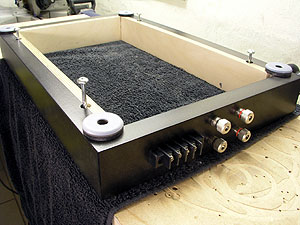
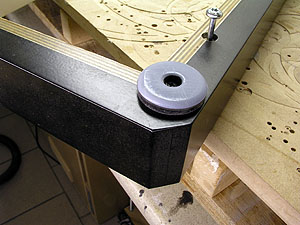
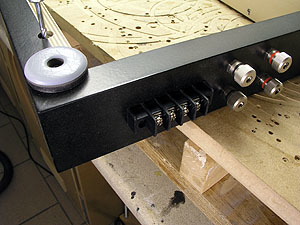
Base for speakers shaping up. On the
rear I have a terminal bar for setting tweeter attenuation, three
levels possible (R1011 = 3R9, 4R7 and 5R6).
The feet I use are rubber with a teflon coating; found a a local home-diy
market. Makes it easy to move the speaker around and this speaker is
so heavy it doesn't matter what you use.
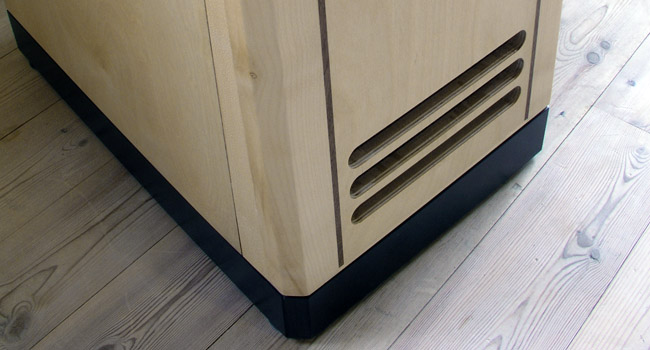
For the TL port I routed three slots of
22 mm width and 200 mm length.
Measurements,
mid tweeter section
Back to top
Measurements may give us an idea of tonal
balance of a system, i.e. too much or too little energy in certain
areas. Measurements may tell us about bass extension if far-field
measurements are merged with near-field measurements. In addition to
this ports may contribute to bass extension. Most of us diy'ers do not
have access to an anechoic room for full-range measurements from
20-20000 Hz. What cannot be seen is what kind of bass performance we
get in a given room. Bass performance is highly dependent on in-room
placement of your speaker and the same speaker can be boomy in one
place and lean in another. Actual SPL level at 1 meter distance and
2.8V input is useful for en estimate of system sensitivity and
combined with the impedance profile may give an idea of how powerful
an amplifier is needed to drive the speaker to adequate levels. What
measurements do not tell is the very sound of the speaker unless
displaying serious linear distortion. The level of transparency, the
ability to resolve micro-details, the "speed" of the bass, etc.,
cannot be derived from these data. Distortion measurements rarely tell
anything unless seriously bad and most modern drivers display low
distortion within their specified operating range. Many people put
way too much into these graphs and my comments here are only meant as
warning against over-interpretation. There are way more to good sound
than what can be extracted from a few graphs. I think I speak for all
of us doing speaker measurements when I say that we learn new things
every time we do one. Every graph needs interpretation in terms of
what it means sonically and how it impacts our choice of mating
drivers, cabinet and crossover design.
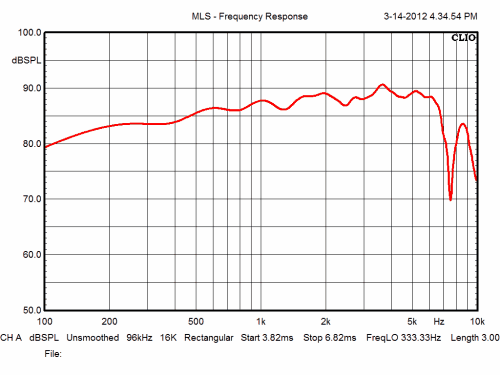
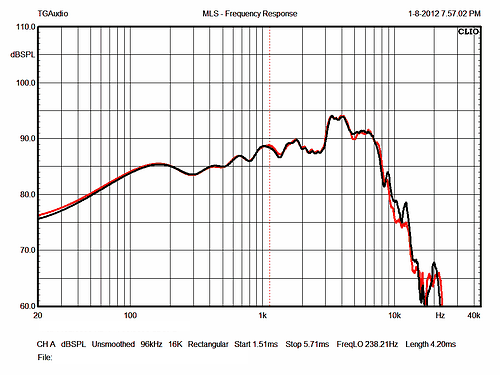
Left: SPL for 18WU/8741T00 on Jenzen mid
baffle. This is the best response I've seen from this driver so far. I
thought the 2.5 kHz dip was kind of intrinsic - and maybe it is, but
on the Jenzen baffle we have a nice smooth response all the way to 6
kHz except for the usual 1 kHz rubber surround resonance.
Right: Same driver on 25 cm baffle. I think this clearly
demonstrates the importance of spending time on cabinet design. A lot
of trouble can be avoided in the initial stages, where most diy
speakers starts with a dream design and all hell breaks loose when the
problems have to be fixed in the crossover.
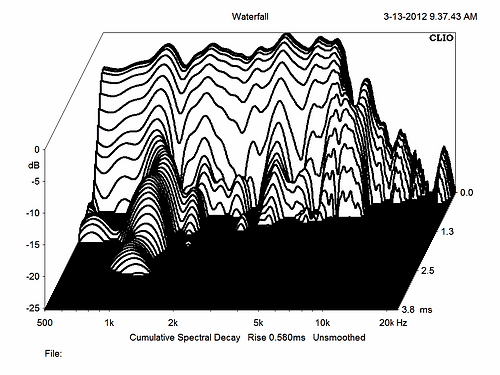
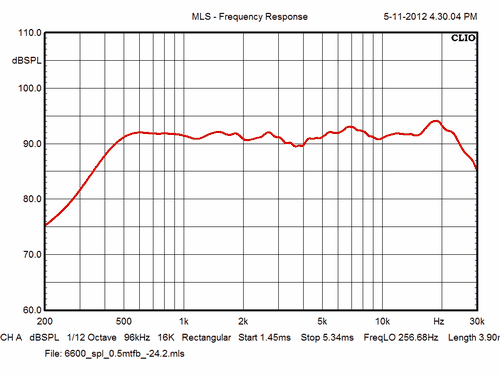
Left: CSD of 18WU/8741T00. The usual
peaky response between 3 and 6 kHz really doesn't show up on waterfall
plot suggesting little energy storage.
Right: Having a stepped baffle can cause trouble for the tweeter, but
this doesn't make trouble designing the crossover.
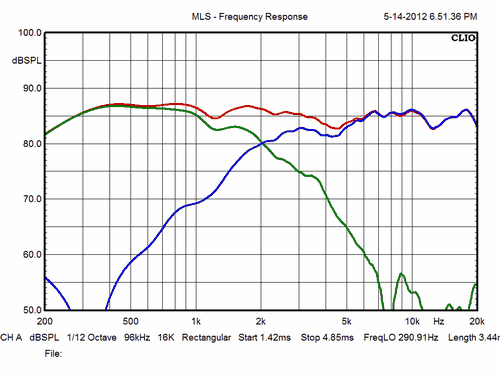
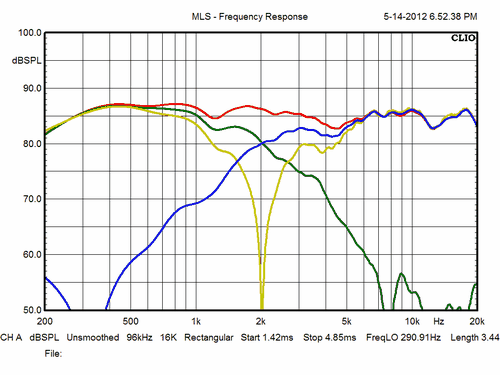
Left: Response from M and T drivers
driven from crossover.
Right: Inverting tweeter polarity makes a deep
suck-out around 2.1 kHz.
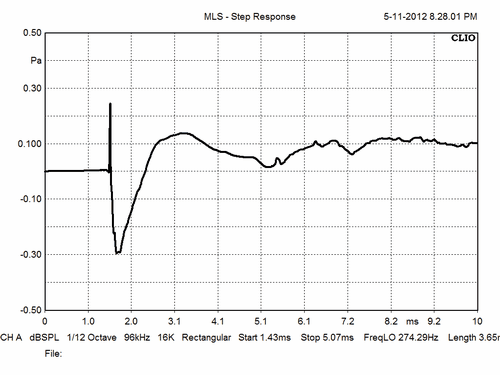 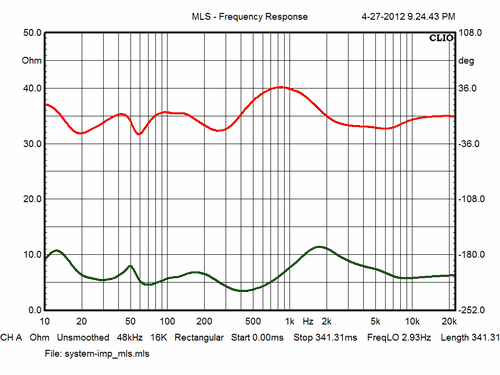
Left:
Step response from MT
section.
Right:Final system impedance. In the critical area we have a minimum
of 4.5 ohms impedance and 3.5 ohms around 400-500 ohms.
Note the
modest phase angles in the bass region thanks to the damping of the
transmission line.
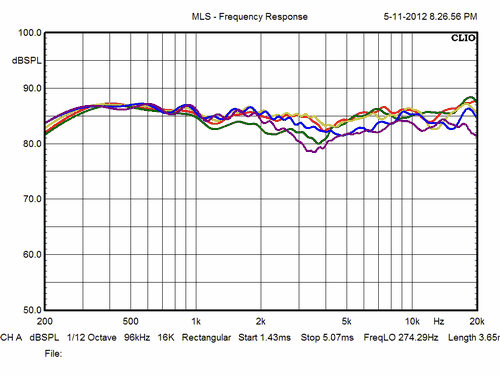 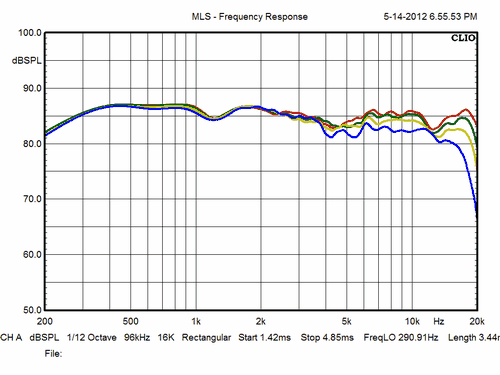
Left: Vertical dispersion measured from
T height to M height (center of drivers). Right: Horizontal
dispersion of MT at 0, 10, 20 and 30 deg.
The
Complete Crossover Kit incl damping materials
Back to top
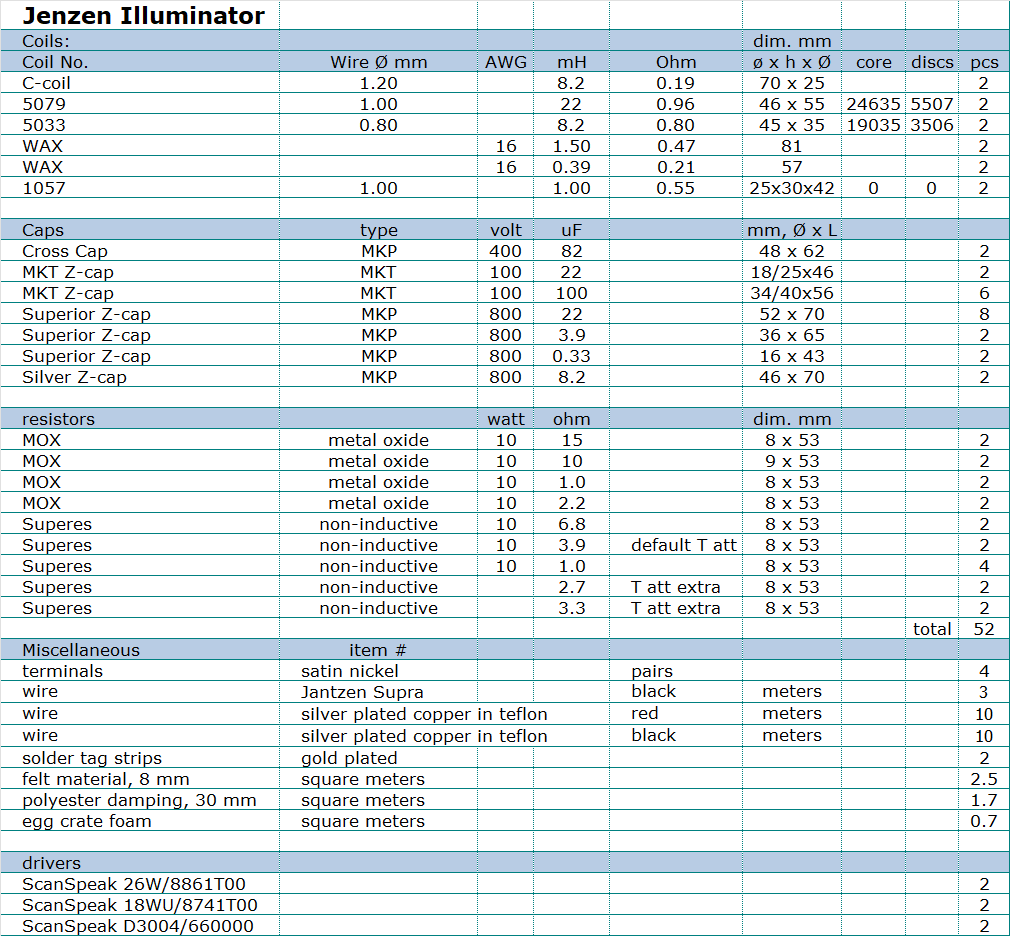
For fresh price quotation
incl. shipping, please contact Jantzen Audio at:
contact@jantzen-audio.com
Download Kit Sale Presentations here:

All kit and component
prices may be subject to change and are always to be confirmed by
Jantzen Audio Denmark.
All technical
questions at:
troels.gravesen@hotmail.com
Crossover Layout
Back to top
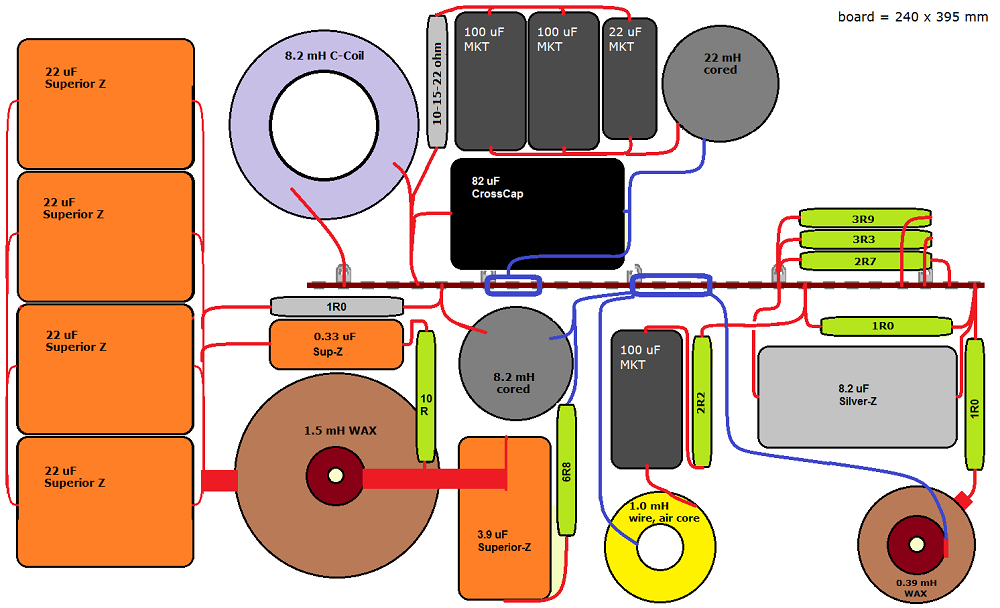
Click image to view large.
As the crossover is going
to be placed at the bottom of the bass cab, we have lots of space and
you may increase board size compared to what is seen above.
Tweeter attenuation resistors were finally decided to be 2R7, 3R3 or
3R9. My default is 3R3, but I know some people like excessive
treble...
Wiring
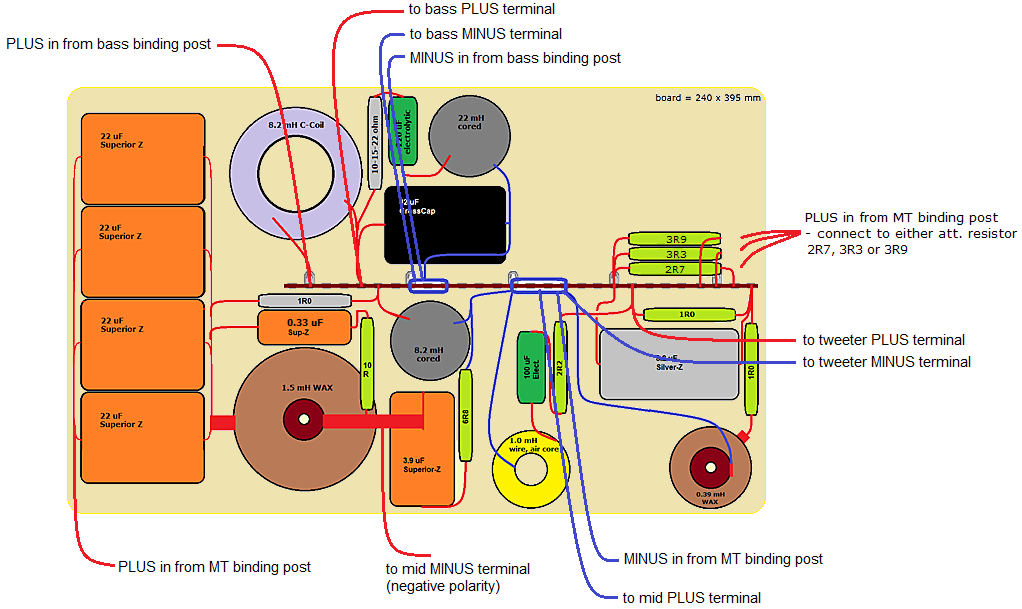
Connecting drivers and
binding posts. The layout is for bi-wiring/bi-amping, thus two pairs
of binding posts needed/speaker. Disregard the changes of
electrolytics to MKT. Wiring is the same.
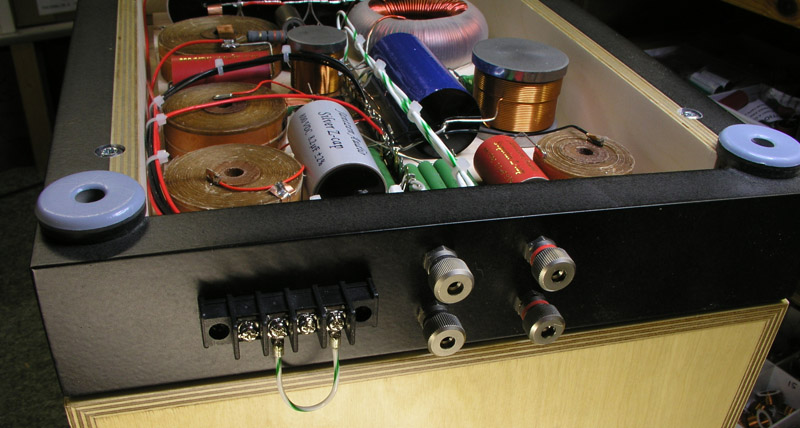
Terminal bar for adjusting tweeter
attenuation. Not actual crossover in picture.
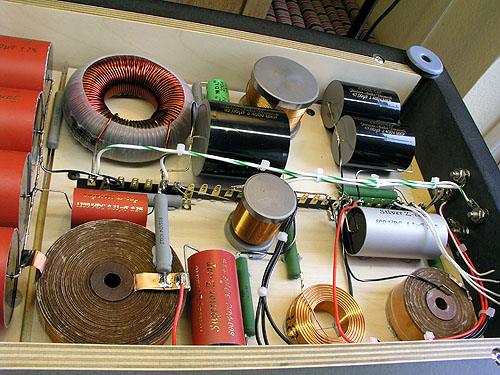
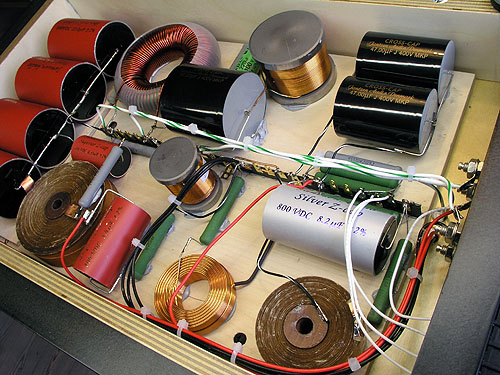
Final crossover in place.
Disregard to
the two CrossCaps, now replaced by 100 uF smooth foil cap.
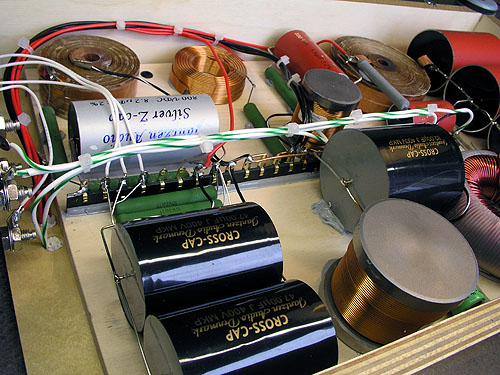
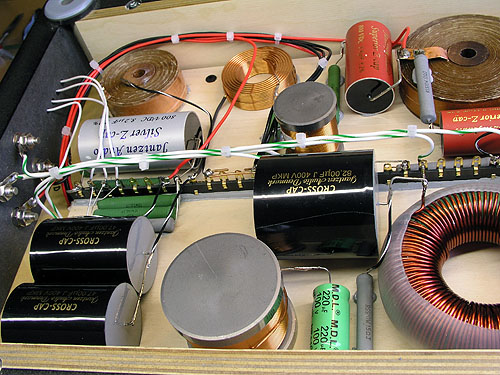
Disregard to the two CrossCaps, now
replaced by 100 uF MKT Z-caps.
Also the 220 uF electrolytic
cap is replaced by 2 x 100 + 1 x 22 uF MKT Z-cap capacitor.
Move
the 22 mH coil to the side to make space for the smooth caps.
|










































